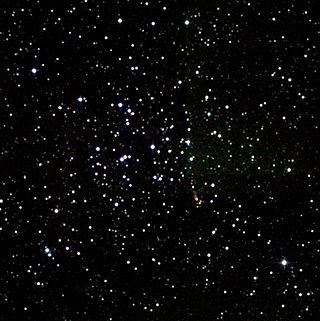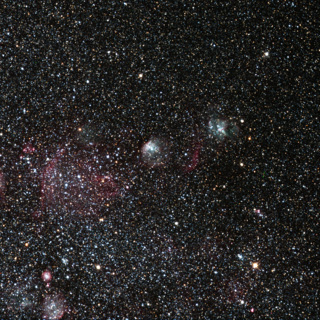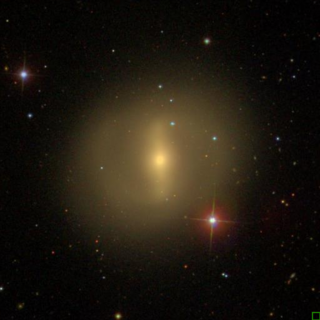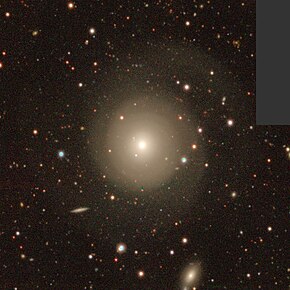
Messier 36 or M36, also known as NGC 1960 or the Pinwheel Cluster, is an open cluster of stars in the somewhat northern Auriga constellation. It was discovered by Giovanni Batista Hodierna before 1654, who described it as a nebulous patch. The cluster was independently re-discovered by Guillaume Le Gentil in 1749, then Charles Messier observed it in 1764 and added it to his catalogue. It is about 1,330 pc away from Earth. The cluster is very similar to the Pleiades cluster (M45), and if as far away it would be of similar apparent magnitude.

Messier 52 or M52, also known as NGC 7654 or the Scorpion Cluster, is an open cluster of stars in the highly northern constellation of Cassiopeia. It was discovered by Charles Messier in 1774. It can be seen from Earth under a good night sky with binoculars. The brightness of the cluster is influenced by extinction, which is stronger in the southern half. Its metallicity is somewhat below that of the Sun, and is estimated to be [Fe/H] = −0.05 ± 0.01.

Messier 53 is a globular cluster in the Coma Berenices constellation. It was discovered by Johann Elert Bode in 1775. M53 is one of the more outlying globular clusters, being about 60,000 light-years (18.4 kpc) light-years away from the Galactic Center, and almost the same distance from the Solar System. The cluster has a core radius (rc) of 2.18 pc, a half-light radius (rh) of 5.84 pc, and a tidal radius (rtr) of 239.9 pc.

NGC 6496 is a globular cluster which is in the direction of the Milky Way's galactic bulge based on observations collected with the WFPC2 on board the Hubble Space Telescope. NGC 6496 was originally believed to be a member of the disc system of the Galactic Center, but scientists questioned this classification. It was instead suggested that NGC 6496, together with two other clusters, NGC 6624 and NGC 6637, could be halo clusters with strongly inclined orbits. NGC 6496 lies in the Southern sky at RA=17:59:03.68 and Dec=-44:15:57.4.

NGC 784 is a barred spiral galaxy about 16.0 Mly away in the constellation Triangulum. NGC 784 is located within the Virgo Supercluster.

NGC 68 is a lenticular galaxy, and the central member of the NGC 68 group, in the constellation Andromeda. The galaxy was discovered on September 11, 1784, by William Herschel, who observed the NGC 68 group as a single object and described it as "extremely faint, large, 3 or 4 stars plus nebulosity". As such, his reported location is between NGC 68, NGC 70, and NGC 71. By the time Dreyer looked at the galaxies to add to the NGC catalog, however, he was able to tell that the single galaxy observed by Herschel was in fact 3 adjacent galaxies, and cataloged them as NGC 68, NGC 70, and NGC 71.

NGC 5256 is an object that contains two disc galaxies, that are colliding into each other. It is located in the constellation Ursa Major, and was discovered by William Herschel on 12 May 1787. The two nuclei of the galaxies are separated by about 13,000 light-years. The southwest and northeast nuclei have masses of 7×109 M☉ and 10×109 M☉, assuming they orbit around a common center of mass. NGC 5256 is located at about 420 million light-years away from the Earth.

NGC 1600 is an elliptical galaxy in the constellation Eridanus, 149 Mly (46 Mpc) away from Earth.

NGC 243 is a lenticular galaxy located in the constellation Andromeda. It was discovered on October 18, 1881 by Édouard Stephan.

NGC 261 is a diffuse nebula located in the constellation Tucana. It was discovered on September 5, 1826, by James Dunlop.

NGC 274 is a lenticular galaxy in the constellation Cetus. It is a pair of galaxies, the other being NGC 275, which it is currently interacting with. It was discovered on September 10, 1785 by William Herschel. It is roughly 120 million light-years away.

NGC 297 is an elliptical galaxy in the constellation Cetus. It was discovered on September 27, 1864, by Albert Marth and is classified as type E3, based on galaxy morphological classification.

NGC 298 is a spiral galaxy in the constellation Cetus. It was discovered on September 27, 1864, by Albert Marth. NGC 298 is situated close to the celestial equator and, as such, it is at least partly visible from both hemispheres in certain times of the year. Given its B magnitude of 14.7, NGC 298 is visible with the help of a telescope having an aperture of 20 inches or more.

NGC 315 is an elliptical galaxy in the constellation Pisces. Its velocity with respect to the cosmic microwave background is 4635 ± 22 km/s, which corresponds to a Hubble distance of 223.0 ± 15.7 Mly (68.36 ± 4.80 Mpc). In addition, eight non-redshift measurements give a distance of 208.58 ± 22.28 Mly (63.950 ± 6.830 Mpc). It was discovered by German-British astronomer William Herschel on September 11, 1784.

NGC 327 is a spiral galaxy in the constellation Cetus. It was discovered on September 27, 1864 by Albert Marth. It is described by Dreyer as "faint, small, extended." It is nearby galaxies NGC 329, NGC 325 and NGC 321.

NGC 337 is a barred spiral galaxy in the constellation Cetus. Its velocity with respect to the cosmic microwave background is 1,331±22 km/s, which corresponds to a Hubble distance of 64.0 ± 4.6 Mly (19.63 ± 1.41 Mpc). Additionally, 20 non-redshift measurements give a similar distance of 63.11 ± 1.81 Mly (19.350 ± 0.556 Mpc). It was discovered on September 10, 1785 by German-British astronomer William Herschel. It was described by John Dreyer as "pretty faint, large, extended, gradually a little brighter middle, 10th magnitude star 21 seconds of time to the east."

NGC 375 is an elliptical galaxy located in the constellation Pisces. It was discovered on September 12, 1784 by William Herschel. It was described by Dreyer as "pretty faint, small, round, brighter middle." Along with galaxies NGC 379, NGC 380, NGC 382, NGC 383, NGC 384, NGC 385, NGC 386, NGC 387 and NGC 388, NGC 375 forms a galaxy cluster called Arp 331.

NGC 380 is an elliptical galaxy located in the constellation Pisces. It was discovered on September 12, 1784 by William Herschel. It was described by Dreyer as "pretty faint, small, round, suddenly brighter middle." Along with galaxies NGC 375, NGC 379, NGC 382, NGC 383, NGC 384, NGC 385, NGC 386, NGC 387 and NGC 388, NGC 380 forms a galaxy cluster called Arp 331.

NGC 410 is an elliptical galaxy located in the constellation Pisces. It was discovered on September 12, 1784 by William Herschel. It was described by Dreyer as "pretty bright, pretty large, northeastern of 2.", the other being NGC 407.

NGC 4665, also catalogued as NGC 4624 and NGC 4664, is a barred lenticular or spiral galaxy located in the constellation Virgo. It is a member of the Virgo II Groups, a series of galaxies and galaxy clusters strung out from the southern edge of the Virgo Supercluster. It is located at a distance of circa 60 million light years from Earth, which, given its apparent dimensions, means that NGC 4665 is about 75,000 light years across. NGC 4665 lies 2 and 3/4 degrees east-south east of Delta Virginis and 50 arcminutes southwest of 35 Virginis. It can be viewed through a moderately sized telescope with 23x magnification, forming a pair with an 11th magnitude star 1.5 arcminutes southwest. It is part of the Herschel 400 Catalogue.





















